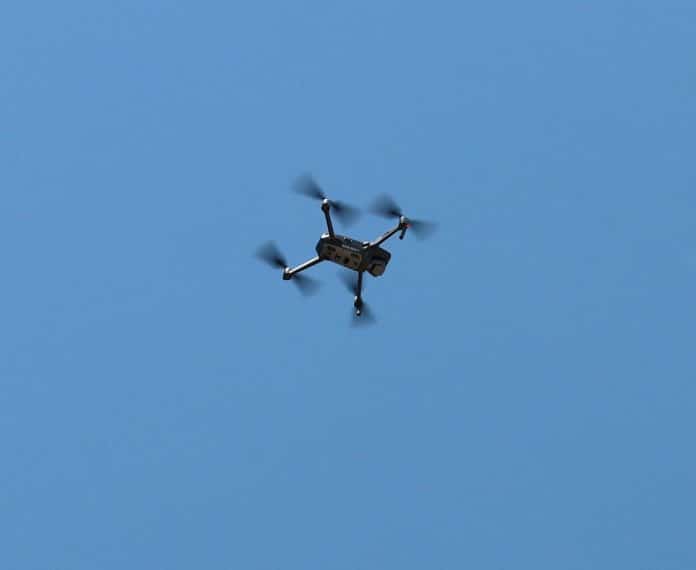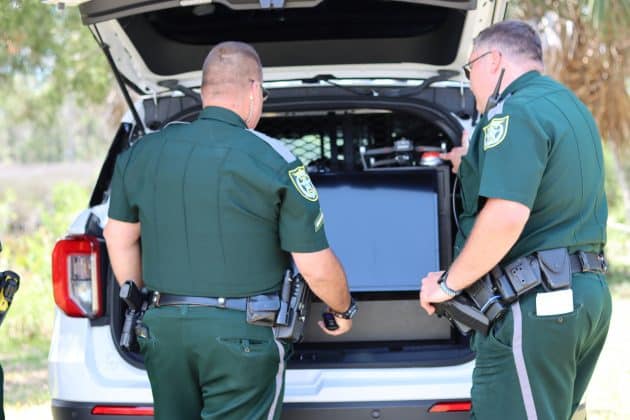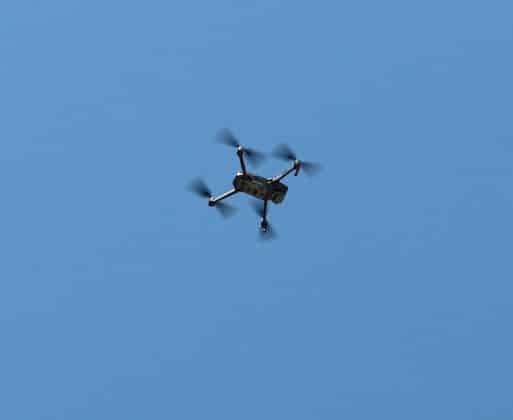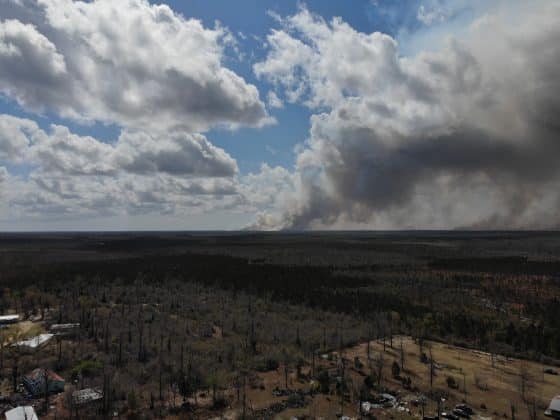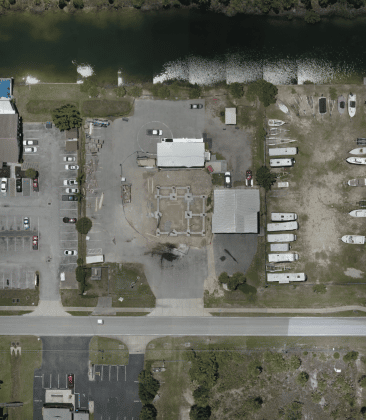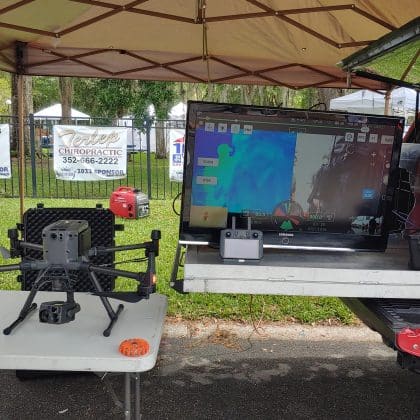Hernando County First Responders Utilize Modern Technology in their Work
Not many people know that drones have been around since the early 1900s. Most people associate them with realistic action films or “way out there” science fiction sagas, such as “Captain Phillips,” “Eye in the Sky,” “Blade Runner 2049” and “Chappie.” Once the stuff of fiction, now drones are used for recreational purposes, business activities and military operations. The use that most closely relates to the safety of the general public is that of our first responders.
The Hernando County Sheriff’s Office (HCSO) and the Hernando County Fire and Emergency Services (HCFES) utilize drones in many of their operations. The HCSO has had a drone unit since November of 2019. The HCFES has had their unit operational since October of last year. These two agencies have worked together on several operations and are planning on doing joint training this summer.
Corporal Mike Woodward, a 10-year veteran of the sheriff’s office, was the one who proposed the idea of a drone unit to Sheriff Nienhuis. Currently they have seven deputies who are certified drone pilots. They have to take the FAA Part 107 course and then pass a test in order to be certified. The test is almost equivalent to a basic knowledge test for a fixed-wing pilot. The members of the drone unit all have other duties. Some are traffic deputies, others are detectives, while others are patrol deputies, etc.
The drones are useful in many situations. For example, they have been used to find missing persons, suspects fleeing and to assist fire rescue and forestry in locating brush fires, as well as determining the size and direction of the fire.
“Drones bridge the gap between the time a call comes in and the time the Aviation Unit can get on scene. They’re kept in agency vehicles so that they are readily available,” remarked Cpl. Woodward.
Sometimes a helicopter isn’t even needed, so it saves quite a bit of money for the agency. Whereas a helicopter burns gallons of fuel in a short period of time, the only cost with the drones is charging or replacing the batteries when needed, and sometimes the propellers. In most cases, drones can often get to the scene faster than a helicopter can.
There are 13 drones in use at the present time. Four are smaller drones that can be used inside a structure or a confined area. Five of the drones have spotlights, speakers and infrared capabilities, which allow them to fly at night.
During the day, one deputy can work on a drone operation alone, but at night two deputies are required. One is the pilot and the other, a visual observer, who keeps an eye on the drone at all times. All the deputies in the agency are trained as visual observers. Pilots must obey all the FAA rules and are not allowed to fly higher than 400 feet. All drones must also be kept in visual line of sight.
Sometimes two or more drones will be used in an operation. This occurs when there is a large area to cover. One drone will fly at one height and the other will fly at a different height. Also, having multiple drones working together allows for one to be in the air while the drone’s battery is being charged. Generally, a charge will last 30 to 40 minutes.
The drone transmits an image of what it sees to a monitor in the vehicle. However, due to privacy issues per agency policy, the Sheriff’s Office does not take photographs or record video unless it’s included in a search warrant. The drone can also zoom in to obtain a clearer image.
Nick Brandt is the UAS (Unmanned Aerial Systems) Program Coordinator for Fire and Emergency Services. He’s been with HCFES since 2009 and with the unit since its inception. Brandt wrote the grant to obtain the funds for the drone unit and then wrote another grant for training the operators.
Like the sheriff’s office, the HCFES drone operators have other duties besides the ones involved in the unit. Some are EMTs; others, like Brandt, are driver engineers and some are fire fighters. Currently, there are fourteen certified pilots.
Just in the past nine months, the drone unit has participated in locating and tracking brush fires and worked with the sheriff’s office at the scene of a traffic accident. In this instance, it was a night time crash and while the EMTs were helping the victims, the deputies used their drone to search for individuals who might have been ejected from the vehicle. “It was a quick way to search a wide area,” stated Brandt.
The drone unit was also deployed to Bay County in the Florida panhandle to help those officials gather information on a brush fire they were dealing with. While they were there they helped with an airplane crash incident, as well.
Another case involved an individual who fell off a horse while riding in the Croom Forest area and was injured. He was able to call 911 and give the dispatcher his approximate location. The drone operator located the rider and helped guide EMTs to the location. Who knows what might have happened to this person if the drone had not located him.
Another aspect of drones is that they have two-dimensional mapping capabilities. This means they are capable of taking multiple pictures overlapping an area and, using a computer program, the drone personnel are able to stitch those images together to make one large picture.
“This is particularly useful during times of natural disaster, such as hurricanes, severe thunderstorms that may produce tornadoes, or wildfires. We are able to fly over damage paths and collect this data for the map which we then can send to the State Emergency Management team as well as FEMA. This allows them to see the damage within minutes to hours of it occurring in order to be able to declare a state of disaster without having to have state or federal officials put boots on the ground. It’s incredibly efficient and cost-effective,” Brandt remarks.
There is an endless array of situations in which first responders can and do use drones. However, the future is not entirely rosy. Starting in January 2023, many of these agencies will not be allowed to use the drones they are currently using. In 2021, the Florida legislature passed a bill (Senate Bill 44, Statute 934.50 subsection 7) stating that all state agencies had to use drones purchased from a select four United States companies. Currently most of the agencies are using drones manufactured in China. The reason given for passing the bill was security issues.
The approved vendors for the procurement of drones are Skydio, Parrot, Altavian, Teal Drones and Vantage Robotics. Under the new law, an approved manufacturer must provide appropriate safeguards to protect the confidentiality, integrity, and availability of data collected, transmitted, or stored by a drone.
A provision that would widen the choice of companies to include manufacturers that the Department of Defense uses was included in another bill brought before the legislature this year (Senate Bill 2512), but the governor vetoed that bill.
According to a source at the Hernando County Fire and Emergency Services, this law will be detrimental to the first responders and other agencies that have to comply with these rules because the Chinese-made drones are more technologically advanced and less expensive than the ones produced by the American companies.
“It’s going to make it harder to accomplish the things we can do now and it’s going to be at an increased cost. They [the U.S. companies] are working on trying to catch up [with Chinese technology], but in the meantime, it will make it more difficult for us to keep doing what we’re doing,” states Brandt.
Another drawback is that these agencies will not be compensated for the drones that they have to return to the funding entities. And the state hasn’t provided funding mechanisms to purchase the new drones.
“We’re struggling to get approved manufacturers to meet our needs through technology and affordability with the approved equipment we’ve been legislatively told to purchase,” Brandt continues. “We hope to find some private sources of funding to purchase these other drones to keep our program running. It’s a valuable tool. It’s cost-effective, safe and life-saving.”
In the meantime, the Hernando County Sheriff’s Office and the Hernando County Fire and Emergency Services will continue to use drones in a myriad of situations. Many hope that the law will be amended in some way or that the U.S. companies will be incentivized to improve the technology of their drones and lower their cost.
As is the case with every challenge, a positive “can-do” attitude is vital.
“We’re going to find ways to make this work because it’s a technology that is not going away. We’ll do the best we can. We want to keep our program working within the confines of the new law,” Brandt concludes.

